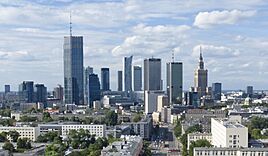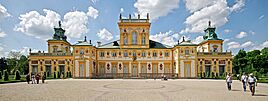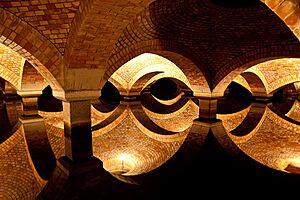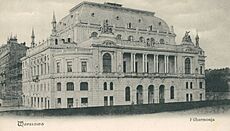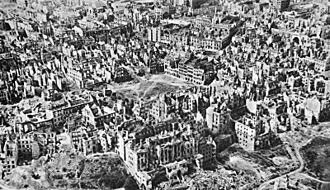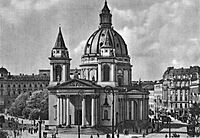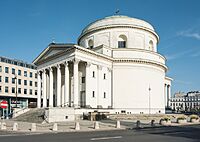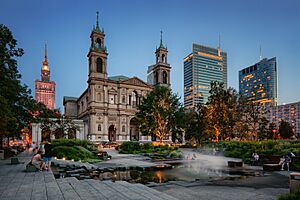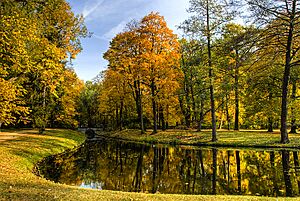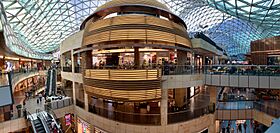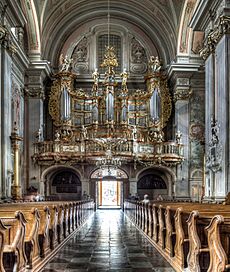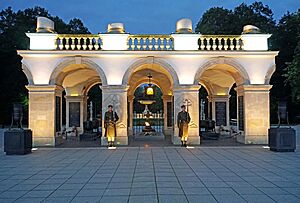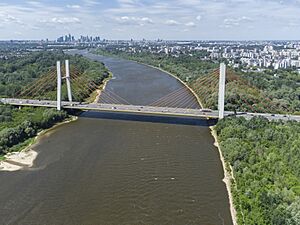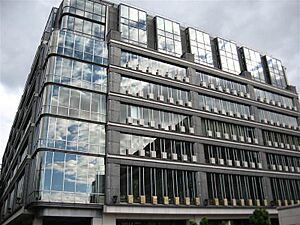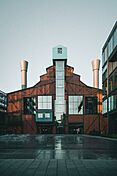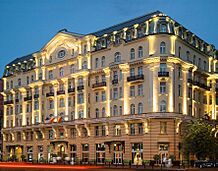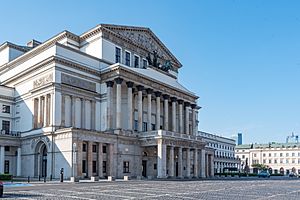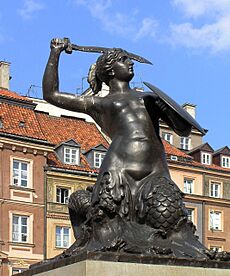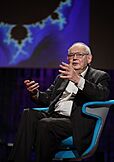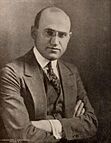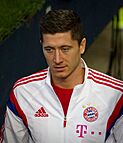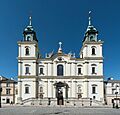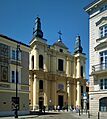Warsaw facts for kids
Quick facts for kids
Warsaw
Warszawa (Polish)
|
|||||
|---|---|---|---|---|---|
|
Capital city and county
|
|||||
| Capital City of Warsaw Polish: miasto stołeczne Warszawa |
|||||
|
The Downtown district
Royal Castle and Sigismund's Column
Nicolaus Copernicus Monument
Łazienki Park
Main Market Square
Wilanów Palace
|
|||||
|
|||||
| Nickname(s):
Phoenix City
|
|||||
| Motto(s):
Semper invicta (Latin "Ever invincible")
|
|||||
| Country | |||||
| Voivodeship | |||||
| County | City county | ||||
| Founded | 13th century | ||||
| City rights | 1323 | ||||
| City Hall | Commission Palace | ||||
| Districts | 18 districts | ||||
| Government | |||||
| • Type | Mayor–council government | ||||
| • Body | Warsaw City Council | ||||
| Area | |||||
| • Capital city and county | 517.24 km2 (199.71 sq mi) | ||||
| • Metro | 6,100.43 km2 (2,355.39 sq mi) | ||||
| Elevation | 78–116 m (328 ft) | ||||
| Population
(2023)
|
|||||
| • Capital city and county | |||||
| • Rank | 1st in Poland 7th in European Union |
||||
| • Density | 3,601/km2 (9,330/sq mi) | ||||
| • Metro | 3,269,510 | ||||
| • Metro density | 509.1/km2 (1,319/sq mi) | ||||
| Demonym(s) | Varsovian | ||||
| GDP | |||||
| • Capital city and county | €77.957 billion (2021) | ||||
| • Metro | €114.436 billion (2022) | ||||
| Time zone | UTC+1 (CET) | ||||
| • Summer (DST) | UTC+2 (CEST) | ||||
| Postal code |
00-001 to 04-999
|
||||
| Area code(s) | +48 22 | ||||
| City budget | zł 24.368 billion (€5.4 billion) |
||||
| International airports | Chopin (WAW) Modlin (WMI) (not in Warsaw) |
||||
| Rapid transit system | Metro | ||||
| Official name: Historic Centre of Warsaw | |||||
| Type: | Cultural | ||||
| Criteria: | ii, vi | ||||
| Designated: | 1980 (4th session) | ||||
| Reference #: | 30 | ||||
| UNESCO region: | Europe | ||||
Warsaw, officially known as the Capital City of Warsaw, is the largest city and capital of Poland. It sits on the River Vistula in east-central Poland. About 1.86 million people live in Warsaw, and its larger metropolitan area has 3.27 million residents. This makes Warsaw the 7th most populated city in the European Union.
The city covers 517 square kilometers and has 18 districts. Warsaw is a major cultural, political, and economic center. It is also the capital of the Masovian Voivodeship.
Warsaw started as a small fishing town. It became important in the late 1500s when King Sigismund III moved the Polish capital from Kraków to Warsaw. It was the main capital of the Polish–Lithuanian Commonwealth until 1795. Later, it was the capital of Napoleon's Duchy of Warsaw. In the 1800s, during the Industrial Revolution, many people moved to Warsaw, making it one of Europe's largest cities.
Warsaw was known for its beautiful buildings and streets. However, it was heavily damaged during World War II. The city was bombed and attacked in 1939. Much of its historic areas were destroyed, and many people were lost during the Warsaw Ghetto Uprising in 1943 and the Warsaw Uprising in 1944.
Today, Warsaw has two international airports: Warsaw Chopin and Warsaw Modlin. The city has a great public transport system, including the Warsaw Metro, buses, and trams. Warsaw is a key economic hub in the region. The Warsaw Stock Exchange is the largest in Central and Eastern Europe. It is also home to Frontex, a European Union agency for border security. Warsaw has many tall buildings, and the Varso Place is the tallest building in the European Union.
The city has important schools and cultural places. These include the University of Warsaw, the Warsaw University of Technology, and the National Museum. The rebuilt Old Town, which shows different European building styles, became a World Heritage Site in 1980. Other famous places are the Royal Castle, Sigismund's Column, and Łazienki Park. Warsaw is a green city, with about a quarter of its area covered by parks. In sports, Legia Warsaw football club is based here, and the city hosts the annual Warsaw Marathon.
Contents
- Understanding Warsaw's Name
- Warsaw's Journey Through Time
- Warsaw's Location and Landscape
- Warsaw's Look and Buildings
- Warsaw's People
- Warsaw's Economy
- Learning in Warsaw
- Getting Around Warsaw
- Warsaw's Culture
- Sports in Warsaw
- Famous People from Warsaw
- Warsaw's Global Connections
- Images for kids
- See also
Understanding Warsaw's Name
Warsaw's name in Polish is Warszawa. The exact meaning of the name is not fully known. One idea is that Warszawa means "belonging to Warsz." Warsz is a shorter version of an old Polish name, Warcisław.
There is a popular story that says the city's name comes from two people: Wars and Sawa. In one version, Sawa was a mermaid in the Vistula River, and a fisherman named Wars fell in love with her. The full official name of the city is miasto stołeczne Warszawa, which means "The Capital City of Warsaw."
People who live in Warsaw are called Varsovians. In Polish, this is warszawiak (male) or warszawianka (female).
Warsaw's Journey Through Time
Early Beginnings (1300s-1800s)
The first settlements in Warsaw were in Bródno (9th/10th century) and Jazdów (12th/13th century). After Jazdów was attacked, a new settlement was built where a small fishing village called "Warszowa" stood. Around 1300, the Prince of Płock, Bolesław II of Masovia, founded the modern city. Warsaw became a main city for the Dukes of Masovia and the capital of the Masovian Duchy in 1413. At that time, about 4,500 people lived there, working in crafts and trade.
In the 1400s, people moved outside the city walls and created a new area called New Town. The older settlement became known as the Old Town. Both areas had their own rules. New Town was created for new people, especially Jews, who were not allowed to live in Old Town.
In 1526, Masovia became part of the Kingdom of Poland. In 1529, Warsaw became the meeting place for the General Sejm (parliament). This led to new defenses, like the Barbican. Famous Italian architects helped rebuild the Royal Castle and other parts of the Old Town. In 1573, the Warsaw Confederation was signed here, giving religious freedom in the Polish–Lithuanian Commonwealth.
Warsaw became the capital of the Commonwealth in 1596. This happened when King Sigismund III Vasa moved his royal court from Kraków. The city grew a lot to the south and west. Between 1655 and 1658, the city was attacked and looted by Swedish, Brandenburgian, and Transylvanian armies.
The time of Kings Augustus II and Augustus III (1700s) was a period of growth for Warsaw. Many German architects helped rebuild the city. The Saxon Garden opened in 1727, becoming the first public park. The Załuski Library, Poland's first public library, opened in 1747. King Stanisław II Augustus made Warsaw a center for culture and arts. He expanded the Royal Baths Park and built many palaces. This earned Warsaw the nickname Paris of the North.
In 1795, Warsaw was taken over by the Kingdom of Prussia. It became the capital of the province of South Prussia.
Growth and Challenges (1800s-1939)
In 1806, Napoleon made Warsaw the capital of the Duchy of Warsaw. After Napoleon's defeat in 1815, Warsaw became part of Congress Poland, which was connected to Imperial Russia. The Royal University of Warsaw was founded in 1816.
The November Uprising against Russian rule happened in 1830 but was defeated. In 1861, Russian troops shot at a crowd protesting their control, killing five people.
Warsaw grew a lot in the 19th century under Mayor Sokrates Starynkiewicz (1875–92). He brought the first water and sewer systems, designed by English engineer William Lindley. Trams, street lighting, and gas systems also expanded. Between 1850 and 1882, the population grew by 134% to 383,000. Many people moved from nearby villages to find work in the city's growing industries.
Factories for metal, textiles, and glass were built. Poorer residents moved to areas like Praga or Powiśle. Jewish people settled in crowded northern Warsaw, in Muranów. By 1897, Warsaw was the third-largest city in the Russian Empire. New buildings like the Warsaw Philharmonic and the Church of the Holiest Saviour were built.
During World War I, Germany occupied Warsaw from 1915 to 1918. After the war, Poland became independent again, forming the Second Polish Republic. In 1920, the Battle of Warsaw was fought on the city's outskirts. Poland successfully defended its capital against the Bolshevik Red Army.
Between 1918 and 1939, Warsaw's infrastructure developed greatly. New housing areas were built. In 1921, Warsaw had 1 million people in only 124.7 square kilometers, making it very crowded. The Średnicowy Bridge was built for railways (1921–1931).
World War II and Rebuilding (1939-1989)
On September 1, 1939, Germany invaded Poland, starting World War II. Warsaw was defended until September 27. The city came under German Nazi rule. All higher education was closed. Hundreds of thousands of Jewish people were forced into the Warsaw Ghetto. In 1942, Jews from the ghetto were sent to extermination camps.
On April 19, 1943, Jewish fighters started the Warsaw Ghetto Uprising. They fought for almost a month against the German army, despite being outnumbered. Most survivors were killed, but some managed to escape.

By July 1944, the Red Army was close to Warsaw. The Polish government-in-exile in London ordered the underground Home Army (AK) to try and take control of Warsaw before the Red Army arrived. The Warsaw uprising began on August 1, 1944. The fighting lasted 63 days. The Home Army and civilians were forced to surrender. They were sent to prisoner of war camps, and all civilians were forced to leave the city. Between 150,000 and 200,000 Polish civilians died.
Adolf Hitler ordered the entire city to be destroyed. About 85% of Warsaw was ruined, including the historic Old Town and the Royal Castle.
On January 17, 1945, Soviet and Polish troops entered the ruins of Warsaw and freed it from German occupation.
In 1945, Warsaw was mostly rubble. The area of the former ghetto was completely flat. The government temporarily moved to Łódź. However, Warsaw officially became the capital of Poland again.
After World War II, a campaign called "Bricks for Warsaw" helped rebuild the city. Many new apartment buildings were built to solve the housing shortage. Some 19th-century buildings that survived were still torn down in the 1950s and 1960s. The central area, Śródmieście, was completely changed. Streets were widened for traffic. The 237-meter Palace of Culture and Science, a gift from the Soviet Union, was built.

John Paul II visited Poland in 1979 and 1983. His visits supported the growing "Solidarity" movement against communism. In 1979, he spoke in Warsaw, calling to "renew the face" of Poland. This inspired many Poles to seek democratic changes.
Modern Warsaw (1989-Present)
In 1995, the Warsaw Metro opened its first line. A second line opened in 2015. By 2023, Warsaw's mayor announced plans to double the metro system by 2050.
Since Poland joined the European Union in 2004, Warsaw has seen a big economic boom. The city hosted the opening game of UEFA Euro 2012. It also hosted the 2013 United Nations Climate Change Conference and the 2016 NATO Summit. In 2022, Warsaw welcomed about 180,000 refugees from Ukraine due to the 2022 Russian invasion of Ukraine. This number is about a tenth of the city's population.
Warsaw's Location and Landscape
Where is Warsaw Located?
Warsaw is in east-central Poland. It is about 300 km from the Carpathian Mountains and 260 km from the Baltic Sea. The city is located on the Vistula River. It sits in the middle of the Masovian Plain. The average height above sea level is 100 meters.
The highest point on the left side of the city is 115.7 meters high. On the right side, it's 122.1 meters high. The lowest point is 75.6 meters high, by the Vistula River. There are also some hills in the city, like Warsaw Uprising Hill (121 m) and Szczęśliwice hill (138 m), which is the highest point in Warsaw.
Warsaw is built on two main landforms: a flat plateau and the Vistula Valley. The Vistula River divides the city into two parts. The left side is on the plateau and the Vistula terraces. A notable feature is the Warsaw Escarpment, which is 20-25 meters high in the Old Town.
The right side of Warsaw has different landforms, including several levels of Vistula terraces. These areas often have sand dunes and peat swamps. Many of these areas are covered by pine forests.
Warsaw's Weather
Warsaw has a climate that is a mix of oceanic and humid continental. This means it has features of both.
Winters are cold, sometimes snowy, and cloudy. Summers are warm and sunny, but often have storms. Spring and autumn can have sudden weather changes. However, temperatures are usually mild, especially in May and September. The average daily temperature is -1.5°C in January and 19.7°C in July. The average yearly temperature is 9.0°C.
Temperatures can reach 30°C in summer. Warsaw is Europe's sixth driest major city. It gets about 482 mm of rain each year, with July being the wettest month.
Warsaw's Look and Buildings
City Design and Architecture
Warsaw's long history has shaped its buildings. Unlike many Polish cities, Warsaw looks very modern. Glass buildings stand tall next to older historic ones. Warsaw has many skyscrapers, including the European Union's tallest building. These tall buildings are mostly in the Śródmieście and Wola districts.
Most people in Warsaw live outside the city center and travel by metro, bus, or tram. Older apartments in central areas are often used for businesses or tourists. Residential areas are mainly on the edges of the inner city, like Ochota, Mokotów, and Żoliborz.
Warsaw became a royal city in the late 1500s. It had many private palaces and mansions. The best German, Italian, and Dutch architects worked here. Buildings near the Warsaw Old Town show almost every European architectural style. Warsaw has great examples of Gothic, Renaissance, Baroque, and Neoclassical buildings. This mix of styles has led some to call Warsaw the "Paris of the East".
Gothic buildings include churches and old houses. Important Gothic buildings are St John's Cathedral (1390) and St Mary's Church (1411). Renaissance buildings include the Baryczko merchant house (1562) and "The Negro" (early 1600s). The Royal Castle (1596–1619) is a good example of Mannerist style.

Baroque architecture came to Warsaw in the late 1500s. Key early Baroque buildings are St. Hyacinth's Church and Sigismund's Column. The Royal Castle and Ujazdów Castle were rebuilt in this style. Many Baroque palaces were built along the Vistula.
In the 17th and 18th centuries, Warsaw Baroque buildings had many vertical elements and decorations. Tylman van Gameren was a key architect. His works include the Krasiński Palace and Wilanów Palace.
Neoclassical architecture became popular in the late 1700s, thanks to King Stanisław August Poniatowski. This style used simple shapes and was inspired by Roman buildings. Domenico Merlini designed the Palace on the Isle. Other neoclassical buildings include the Great Theater and buildings at Bank Square.
In the mid-1800s, the industrial revolution brought iron as a building material. The Warsaw-Vienna Railway Station opened in 1845. The first modern water supply system started in 1855. Factories like Wedel and the Municipal Gasworks were built.

After World War II, many buildings were rebuilt in a socialist realist style. The Palace of Culture and Science is a famous example. Constitution Square was designed like grand squares in other European cities.
Modern architecture in Warsaw includes the Metropolitan Office Building and Varso tower, both by Norman Foster. The Warsaw University Library has a garden on its roof. Other modern buildings are Rondo 1, Złota 44, and Golden Terraces. Warsaw is one of the European cities with the most skyscrapers.
Famous Places to See

Warsaw is a relatively young city compared to other European capitals. However, it has many famous places and buildings that are centuries old. The Warsaw Old Town was rebuilt after World War II. Its most famous landmarks are the Royal Castle, Sigismund's Column, the Market Square, and the Barbican.
Further south is the Royal Route, with many historic churches and palaces. The Presidential Palace and the University of Warsaw campus are here. The former royal home of King John III Sobieski at Wilanów is known for its Baroque style and beautiful garden.
Warsaw also has many places that remember Jewish culture and history. These include the Jewish theater, the Nożyk Synagogue, and Janusz Korczak's Orphanage. The sad parts of Warsaw's history are remembered at places like the Monument to the Ghetto Heroes and fragments of the ghetto wall.
Many places honor Warsaw's heroic history. Pawiak was a German prison and is now a museum. The Warsaw Citadel was a 19th-century fort where Poles were martyred. The statue of Little Insurrectionist remembers the children who helped in the Warsaw Uprising. The Warsaw Uprising Monument honors the largest uprising of World War II.
Many places in Warsaw are connected to the life of Frédéric Chopin, who was born nearby. His heart is kept inside Warsaw's Holy Cross Church. In summer, concerts are held at the Chopin Statue in Łazienki Park.
Warsaw also has many links to Marie Curie. You can find her birthplace in the Warsaw New Town and the Radium Institute she founded.
Cemeteries in Warsaw

The oldest cemetery in Warsaw is Stare Powązki, started in 1790. It is one of Poland's national cemeteries.
The cemetery covers 43 hectares. Over a million people are buried there. The Avenue of Merit holds graves of soldiers, independence fighters, writers, and artists. The nearby Powązki Military Cemetery was created in 1912 for soldiers.
Warsaw also has non-Catholic cemeteries. These include the Evangelical–Augsburg Cemetery, Jewish Cemetery, and Orthodox Cemetery.
City Memorials
The symbol of Warsaw is the mermaid (syrenka). You can see her on statues and on the city's coat of arms. This symbol has been used since the mid-1300s. The oldest monument in Warsaw is Sigismund's Column, built in 1644. It shows King Sigismund III Vasa holding a cross and a sword.
Many monuments remember heroic and sad moments in Poland's history. The Tomb of the Unknown Soldier is in Piłsudski Square. It was built in 1925 to honor soldiers who died for Poland. Other monuments related to World War II include the Nike Monument and the Warsaw Uprising Monument. The Monument to the Ghetto Heroes remembers the Warsaw Ghetto Uprising.
The Frédéric Chopin's monument was built in 1929 in the Royal Łazienki Park. Concerts are held there every summer. Other important monuments include those for Adam Mickiewicz, Marie Curie, and Nicolaus Copernicus.
Green Spaces and Wildlife
Green spaces cover almost a quarter of Warsaw. These include small neighborhood parks, tree-lined streets, and large historic parks. There are 82 parks in the city. The oldest ones, like the Saxon Garden and Łazienki Park, were once part of palaces.
The Saxon Garden covers 15.5 hectares. It was once a royal garden but became one of the world's first public parks in 1727. The Tomb of the Unknown Soldier is at one end of the park. Łazienki Park covers 76 hectares. It has unique landscapes, sculptures, and plants. You can see peacocks, pheasants, and squirrels there.
The Botanical Garden and the University Library rooftop garden have many rare plants. A palm house in the New Orangery shows subtropical plants. The nearby Kampinos Nature Reserve is a protected part of the Masovian Primeval Forest. It has animals like otters and beavers, and hundreds of bird species.
The Warsaw Zoo covers 40 hectares and has about 5,000 animals from nearly 500 species. It officially opened in 1928.
Warsaw's People
Before World War II, Warsaw was a very diverse city. It had many foreign-born residents, including a large Jewish population. In the late 1930s, about 30% of the city's people were Jewish. There was also a notable German community. Today, Warsaw's population is not as diverse as it once was. Most growth comes from people moving within Poland.
| Nationality | Population |
|---|---|
| 102,634 | |
| 41,834 | |
| 7,773 | |
| 7,438 | |
| 6,032 | |
| 4,179 | |
| 3,867 | |
| 4,037 | |
| 2,088 | |
| 1,891 |
In 1939, about 1.3 million people lived in Warsaw. By 1945, this number dropped to 420,000. After the war, many people moved to Warsaw, causing a housing shortage. The city had to limit who could move in.
The Warsaw metropolitan area is growing fast. It has more than half of the population of the Masovian Voivodeship. It also has most of the highly educated residents and large businesses. The population is expected to keep growing, mainly due to people moving from other parts of Poland and from other countries.
Immigrant Population
In 2019, about 40,000 foreign-born people lived in Warsaw. The largest groups were Ukrainians, Vietnamese, Belarusians, and Russians. After Russia's aggression against Ukraine in 2022, over 1.1 million Ukrainian refugees passed through Warsaw. About 104,000 Ukrainian citizens still live in the city, including 17,000 children in schools. The immigrant population has grown to about 340,000.
Religious Life in Warsaw
Religion in Warsaw (2021) Catholicism (51%) Protestantism (0.6%) Eastern Orthodoxy (0.4%) Other Christian (0.1%) Other (0.2%) Undeclared (29%) Irreligion (19%)
Warsaw has always been a city with many cultures and religions. In 1901, 56.2% of people were Catholic, 35.7% Jewish, and 5% Greek Orthodox. This led to many places of worship being built. Most of them were destroyed in 1944. After the war, new churches were rarely built.
Today, the Archdiocese of Warsaw serves 1.4 million Catholics. The Lutheran Diocese of Warsaw has its main church, the Holy Trinity Church, from 1782. The main church for Orthodox Christians is the Cathedral of St. Mary Magdalene from 1869.
The Jewish Community of Warsaw has three active synagogues, including the pre-war Nożyk Synagogue. There is also an Islamic Cultural Centre and a small mosque for Muslims.
Warsaw's Economy
Warsaw is a major economic and financial center in Central Europe. In 2021, the city's economy was estimated at €100 billion. This makes Warsaw the 20th largest economy among European Union cities. Warsaw produces almost one-fifth of Poland's total economic output. In 2020, Warsaw was recognized as a global city, meaning it connects economic regions worldwide.
Warsaw's city center and the Wola district are home to many national and international companies. In 2019, Warsaw was a top choice for foreign investors in Europe.
The average monthly salary in Warsaw in late 2022 was 8,104 PLN. This was higher than the average for Poland. The highest salaries were in the information and communication sector. Warsaw has 525,475 registered businesses. The city has a lot of office space, over 6.27 million square meters. The largest office buildings are Varso and Warsaw Spire.
In October 2019, Warsaw's unemployment rate was 1.3%, the lowest in Poland. Shopping is a big part of Warsaw's economy. Famous retail streets are New World Street and Krakowskie Przedmieście. Most stores are in large shopping centers like Złote Tarasy-Golden Terraces and Westfield Arkadia.
Warsaw Stock Exchange
Warsaw's first stock exchange opened in 1817. It reopened in 1991 after the end of communism. Today, the Warsaw Stock Exchange (WSE) is the largest market in its region. It has 433 companies listed. From 1991 to 2000, the stock exchange was in the building that used to be the headquarters of the communist party.
Warsaw's Industries
Warsaw's main industries include high-tech, electronics, chemicals, cosmetics, construction, food processing, and printing. Most factories are in the Warsaw Industrial Precinct, around the city's edges. Warsaw also has a strong retail market.
After World War II, the city became a major center for heavy industry. Large factories were built, like Huta Warszawa steel works and the Fabryka Samochodów Osobowych (FSO) car factory. FSO was once Warsaw's most successful company, making cars like the FSO Warszawa and Polski Fiat 125p.
Tourism in Warsaw
In 2022, over 9 million tourists visited Warsaw. Most came from the United Kingdom, Germany, the United States, and France. Another 5.8 million people visited for just one day. The city has 1,010 hotels with over 56,000 beds. Tourism adds 12.9 billion PLN to Warsaw's economy and employs 87,703 people.
The Royal Łazienki Museum was the most popular attraction, with over 5 million visitors. Warsaw is also a major center for conferences and congresses.
Media and Film in Warsaw
Warsaw is Poland's media center. It is home to TVP and many other TV and radio stations. Warsaw also has a large movie and television industry. Several movie companies and studios are located here.
The first Polish newspaper, the Polish Ordinary Mercury, was printed in Warsaw in 1661. Today, Warsaw is a printing capital with many newspapers and magazines. Major Polish newspapers like Rzeczpospolita and Gazeta Wyborcza have their main offices in Warsaw.
Since World War II, Warsaw has been the most important place for film production in Poland. Many Polish and foreign movies have been set in Warsaw, including the Oscar-winning The Pianist. The National Film Archive in Warsaw collects and preserves Polish films.
Learning in Warsaw
Higher Education in Warsaw
|
Higher education in Warsaw
Name and year established
|
Warsaw has some of the best universities in Poland. It has four major universities and over 62 smaller schools. Almost 500,000 students attend schools in Warsaw. Over 280,000 of these are university students. Most famous universities are public, but many private universities have also opened recently.

The University of Warsaw was founded in 1816. It is the largest university in Poland and is known for its math and science programs. The Warsaw University of Technology is the second-largest technical school in Poland. Other important schools include the Medical University of Warsaw, the National Defence University, and the Fryderyk Chopin University of Music.
Warsaw has many libraries with huge collections of historic documents. The most important is the National Library of Poland, which holds 8.2 million items. It continues the work of the Załuski Library, one of the world's first and largest libraries.
The University Library, founded in 1816, has over two million items. Its building, opened in 1999, has a large garden on its roof. This garden is one of the largest roof gardens in Europe and is open to the public.
Getting Around Warsaw
Transportation Systems
Warsaw is a big transport hub connecting Western, Central, and Eastern Europe. The city has a good bus network and a growing metro system. The tram system is one of Europe's largest, with 133 km of tracks. New roads, bridges, and overpasses have been built thanks to foreign investment and EU funding.
Warsaw does not have a full ring road system. This means most traffic goes through the city center, causing a lot of traffic jams. A ring road is planned with express roads S2, S8, and S17.
The A2 motorway opened in 2012. It connects Warsaw directly to Łódź, Poznań, and Berlin.
The city has three international airports. Warsaw Chopin Airport is only 10 km from the city center. Warsaw-Radom Airport is 90 km south and serves low-cost flights. Warsaw-Modlin Airport is 35 km north and opened in 2012. Chopin Airport is very busy, serving over 7 million passengers in 2021.
Public transport also includes the light rail Warszawska Kolej Dojazdowa line, the urban railway Szybka Kolej Miejska, and regional rail Koleje Mazowieckie. There are also bicycle sharing systems like Veturilo. Buses, trams, urban railway, and the Metro are managed by the Public Transport Authority.
Long-distance trains are run by Polish State Railways (PKP). The main railway station is Warszawa Centralna. It serves almost every major city in Poland and has international connections. Warsaw has five other major railway stations.
Warsaw's Culture
Music and Theatre Scene
Warsaw has many music venues. These include the Teatr Wielki, the Polish National Opera, the National Philharmonic Hall, and the National Theatre. The city hosts many events and festivals. Some important ones are the International Frédéric Chopin Piano Competition and the International Contemporary Music Festival Warsaw Autumn.
Warsaw is also known for its underground electronic music scene.
Warsaw has over 30 major theaters. These include the National Theatre (founded in 1765) and the Grand Theatre (established 1778). Many young directors and performers also contribute to Warsaw's theater culture.

From 1833 until World War II, Plac Teatralny was the cultural heart of the country. It hosted parades, celebrations, and concerts. The Great Theatre building housed various theaters and the first state-run academy of dramatic art.
Museums and Art Galleries
|
Museums in Warsaw
|
Warsaw has over 60 museums and galleries. These include the world's first Museum of Posters and the Museum of the History of Polish Jews. The National Museum has art from ancient times to today. The Museum of the Polish Army shows the history of weapons.
The Łazienki and Wilanów palaces have collections of "old masters" paintings. The Royal Castle displays the Lanckoroński Collection, including paintings by Rembrandt.
The Copernicus Science Centre is an interactive museum with over 450 exhibits. Visitors can do experiments and learn about science. Warsaw also has small museums of Evolution and the Earth.
The Carroll Porczyński Collection Museum has a large private art collection. It includes works by famous artists like Pierre-Auguste Renoir and Vincent van Gogh.
The Warsaw Uprising Museum and the Katyń Museum remember sad parts of Warsaw's history. The Warsaw Uprising Museum also has a historic stereoscopic theater. The Museum of Independence keeps objects related to Poland's fight for freedom. The Warsaw Historical Museum shows the city's history from its beginnings.
The Ujazdów Castle houses the Centre for Contemporary Art. The Zachęta National Gallery of Art organizes exhibitions of modern art. The new building of the Museum of Polish History opened in 2023.
Warsaw also has unique museums like the Neon Museum, the Museum of Caricature, and a Motorization Museum.
Food and Cuisine in Warsaw
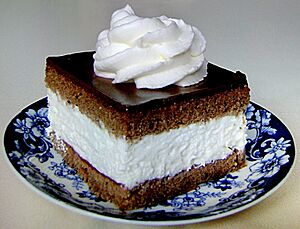
Warsaw's food traditions were shaped by its many cultures, especially Jewish and French influences. Traditional Varsovian food includes tripe soup, pyza dumplings, and the famous wuzetka chocolate cream pie. In the 1920s and 1930s, Crayfish and fish in gelatin were popular dishes.
Like Paris, Warsaw once had a strong café culture dating back to the 1700s. The historic Wedel Chocolate Lounge is still a famous place to meet. Modern coffee shops like Caffè Nero and Starbucks are common along the Royal Route. Many people also buy pączki doughnuts on Fat Thursday.

Restaurants with authentic Polish cuisine are mostly in the Old Town. Spit cakes from Czech Republic or Hungary are also sold there. Hala Koszyki is a popular food hall.
In the 20th century, Warsaw was known for its state-owned milk bars (bar mleczny). These offered cheap, home-style meals. Today, fast food chains like McDonald's are common, but some milk bars have returned.
Fancy restaurants are in the downtown area or the Frascati neighborhood. In 2019, thirteen Warsaw restaurants were recognized by the Michelin Guide. In 2021, National Geographic named Warsaw one of Europe's top cities for vegans.
City Events
Several events happen every year in Warsaw. The Orange Warsaw Festival features music concerts. A popular event is the procession of the Three Wise Men on Epiphany in January. People wear paper crowns, and city officials attend.
Thousands of people gather on the Vistula River banks for Wianki (Wreaths) on Midsummer's Night. This festival comes from an old pagan ritual where maidens floated wreaths to predict their marriages. Today, it includes concerts, fairs, and fireworks.
The Warsaw Multimedia Fountain Park has "Water – Light – Sound" shows every Friday and Saturday from May to September.
The Warsaw Film Festival happens every October. It shows over 100 films, and awards are given to the best ones.
The Warsaw Mermaid Symbol
The mermaid (syrenka) is Warsaw's symbol. You can see her on statues and the city's coat of arms. This symbol has been used since the mid-1300s.
The Mermaid Statue stands in the center of Old Town Square. The original statue was moved to the Museum of Warsaw because of vandalism, and a copy is now in the square. Another mermaid statue is on the Vistula River bank.
The origin of the mermaid legend is not fully known. One popular story says that two of Triton's daughters traveled the seas. One stayed in Denmark, and the other came to the Vistula River. She rested by a village called Warszowa, where fishermen admired her singing. A greedy merchant captured her, but she was saved.
Another legend says a mermaid swam to Warsaw from the Baltic Sea for the love of the Griffin, the city's old defender. After the Griffin was killed, the mermaid became Warsaw's protector.
Members of the Queen's Royal Hussars and 651 Squadron Army Air Corps in the UK wear the "Maid of Warsaw" crest on their uniforms.
Sports in Warsaw
In 2008, Warsaw was named the European Capital of Sport.

The Kazimierz Górski National Stadium is a large football (soccer) stadium with 58,580 seats. It replaced the old 10th-Anniversary Stadium. The National Stadium hosted the opening match and several other games for UEFA Euro 2012.
Warsaw has many sports centers, including swimming pools and sports halls. The main indoor venue is Hala Torwar, used for various indoor sports and as an ice rink. There is also an outdoor ice rink (Stegny) and a horse racetrack (Służewiec).
The most famous football team in Warsaw is Legia Warsaw. They play at the Polish Army Stadium. Founded in 1916, they have won the country's championship fifteen times and the Polish Cup nineteen times. They reached the quarter-finals of the 1995–96 UEFA Champions League.
Their local rivals, Polonia Warsaw, have fewer supporters. They have won the championship twice and the cup twice. Polonia's home is at Konwiktorska Street.
Legia Warsaw's basketball team was one of the best in the 1950s and 1960s. They now play in the top Polish basketball league.
Famous People from Warsaw
One of the most famous people born in Warsaw was Maria Skłodowska-Curie. She was the first woman to win a Nobel Prize for her work on radioactivity. Famous musicians include Władysław Szpilman, Frédéric Chopin, and Witold Lutosławski. Chopin moved to Warsaw when he was seven months old. Casimir Pulaski, a Polish general and hero of the American Revolutionary War, was born here in 1745. Other important people who lived in Warsaw include Rosa Luxemburg and Ludwik Zamenhof.
Tamara de Lempicka was a famous artist born in Warsaw. She was known for her art deco paintings. Another notable artist was Wojciech Fangor, known for his abstract art. Nathan Alterman, an Israeli poet, and Moshe Vilenski, an Israeli composer, were also born in Warsaw.
Osip Mandelstam, a Russian Jewish poet, was born in Warsaw. Other famous people include Samuel Goldwyn, who founded Goldwyn Pictures, mathematician Benoit Mandelbrot, physicist Joseph Rotblat, and biochemist Casimir Funk. Warsaw was a beloved city for Isaac Bashevis Singer, who wrote about it in his novels. Famous sports figures born in Warsaw include footballers Robert Lewandowski and Wojciech Szczęsny, and tennis player Iga Świątek.
Warsaw's Global Connections
Twin Towns and Sister Cities
Warsaw has "twin town" or "sister city" relationships with many cities around the world. This means they work together on cultural and other projects.
Former twin towns:
Partnership and Friendship Cities
Warsaw also works with other cities in partnerships:
 Budapest, Hungary (2005)
Budapest, Hungary (2005) Buenos Aires, Argentina (1992)
Buenos Aires, Argentina (1992) Coventry, United Kingdom (1957)
Coventry, United Kingdom (1957) The Hague, Netherlands (1991)
The Hague, Netherlands (1991) Hamamatsu, Japan (1990)
Hamamatsu, Japan (1990) Harbin, China (1993)
Harbin, China (1993) Île-de-France, France (1990)
Île-de-France, France (1990) Istanbul, Turkey (1991)
Istanbul, Turkey (1991) Madrid, Spain (1981)
Madrid, Spain (1981) Manila, Philippines (2006)
Manila, Philippines (2006) Oslo, Norway (2006)
Oslo, Norway (2006) Paris, France (1999)
Paris, France (1999) Saint-Étienne, France (1995)
Saint-Étienne, France (1995) Toronto, Canada (1990)
Toronto, Canada (1990) Vienna, Austria (1991)
Vienna, Austria (1991) Yerevan, Armenia (2013)
Yerevan, Armenia (2013)
Former partner cities:
 Saint Petersburg, Russia (1997–2022)
Saint Petersburg, Russia (1997–2022)
Images for kids
-
Inside Holy Cross Church there is an epitaph with Chopin's heart
-
Krasiński Palace, a branch of the National Library
-
Staszic Palace, the seat of the Polish Academy of Sciences
-
Casimir Palace housed the Warsaw Lyceum whose alumni included Frédéric Chopin
-
Entrance to botanical garden located on the roof of University Library
-
A red squirrel in one of Warsaw's parks
-
Copernicus Science Centre, planetarium
-
Metro Line 2, Nowy Świat-Uniwersytet station
-
Pendolino high-speed trains at Warszawa Centralna
See also
 In Spanish: Varsovia para niños
In Spanish: Varsovia para niños


